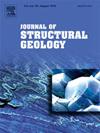Fault zone deformation and fracture intensity in chalk-dominated carbonates
IF 2.9
2区 地球科学
Q2 GEOSCIENCES, MULTIDISCIPLINARY
引用次数: 0
Abstract
Cretaceous Anacacho Limestone within the Balcones fault system (central Texas) is investigated to understand fracturing of chalk-dominated carbonates in a normal faulting deformation regime. Development of opening-mode fractures is highly sensitive to mineralogy and associated mechanical behavior. Low mechanical rebound beds that have >7 % clay and <90 % carbonate generally lack well-developed opening-mode fracture sets. High-rebound beds with <7 % clay and >90 % carbonate contain opening-mode fracture networks. Away from mapped faults (with ∼10 m or greater throw), deformation is represented by opening-mode fractures in two orthogonal sets with intensities of <1 fracture/meter. The NE-SW-striking dominant set parallels regional normal-fault strike. Deformation adjacent to a ∼10-m-throw normal fault includes small-displacement (antithetic and synthetic) normal faults and opening-mode fractures. Near-fault fracture intensity reaches >5 × background levels, and decays to background intensity ∼30 m from the fault. Fluid inclusion analyses of calcite from dilational crack-seal zones along normal faults and opening-mode fractures within the fault damage zone reveal: (i) liquid hydrocarbon inclusions with ∼28–36 API gravity oil; (ii) homogenization temperatures from two-phase inclusions used to estimate burial depths of 0.9–1.5 km (oil inclusions) up to 2.4–2.9 km (aqueous inclusions); and (iii) aqueous inclusion ice-melting temperatures indicating basinal brine rather than near-surface meteoric water during vein cementation. U-Pb ages from these veins indicate Paleocene-Eocene faulting and fracturing (57.9 ± 3.2 to 38.9 ± 4.1 Ma), and limited Miocene (16.6 ± 2.2 Ma) activity. This work documents the essential role of small-displacement faults and opening-mode fractures in the migration of hydrocarbons through low-permeability chalk dominated carbonates.
白垩系碳酸盐岩中断裂带变形与断裂强度
为了了解正常断裂变形条件下白垩系碳酸盐岩的压裂情况,研究了位于德克萨斯州中部的Balcones断裂系统中的白垩系Anacacho灰岩。开敞型裂缝的发育对矿物学和相关力学行为高度敏感。含有7%粘土和90%碳酸盐的低机械回弹层通常缺乏发育良好的张开型裂缝组。含有7%粘土和90%碳酸盐的高回弹层含有张开型裂缝网络。在远离已绘制的断层(距离为~ 10米或更大)的地方,变形由两个正交集的开口型裂缝表示,强度为<;1条裂缝/米。北东-西向的优势构造与区域正断层走向平行。距离约10米的正断层附近的变形包括小位移(对偶和合成)正断层和张开型裂缝。近断层断裂强度达到背景强度的5倍,并在距断层约30 m处衰减到背景强度。对沿正断层和断层破坏带内张开型裂缝的扩张缝封带方解石的流体包裹体分析表明:(1)含~ 28-36 API重质油的液态烃包裹体;(ii)两相包裹体的均一化温度,用于估计埋藏深度为0.9-1.5 km(油包裹体)至2.4-2.9 km(水包裹体);(3)脉体胶结过程中含水包裹体融冰温度表明盆地卤水而非近地表大气水。这些岩脉的U-Pb年龄反映了古新世—始新世的断裂和破裂作用(57.9±3.2 ~ 38.9±4.1 Ma),中新世的活动(16.6±2.2 Ma)较为有限。这项工作证明了小位移断层和张开型裂缝在油气通过低渗透白垩质碳酸盐岩运移过程中的重要作用。
本文章由计算机程序翻译,如有差异,请以英文原文为准。
求助全文
约1分钟内获得全文
求助全文
来源期刊

Journal of Structural Geology
地学-地球科学综合
CiteScore
6.00
自引率
19.40%
发文量
192
审稿时长
15.7 weeks
期刊介绍:
The Journal of Structural Geology publishes process-oriented investigations about structural geology using appropriate combinations of analog and digital field data, seismic reflection data, satellite-derived data, geometric analysis, kinematic analysis, laboratory experiments, computer visualizations, and analogue or numerical modelling on all scales. Contributions are encouraged to draw perspectives from rheology, rock mechanics, geophysics,metamorphism, sedimentology, petroleum geology, economic geology, geodynamics, planetary geology, tectonics and neotectonics to provide a more powerful understanding of deformation processes and systems. Given the visual nature of the discipline, supplementary materials that portray the data and analysis in 3-D or quasi 3-D manners, including the use of videos, and/or graphical abstracts can significantly strengthen the impact of contributions.
 求助内容:
求助内容: 应助结果提醒方式:
应助结果提醒方式:


